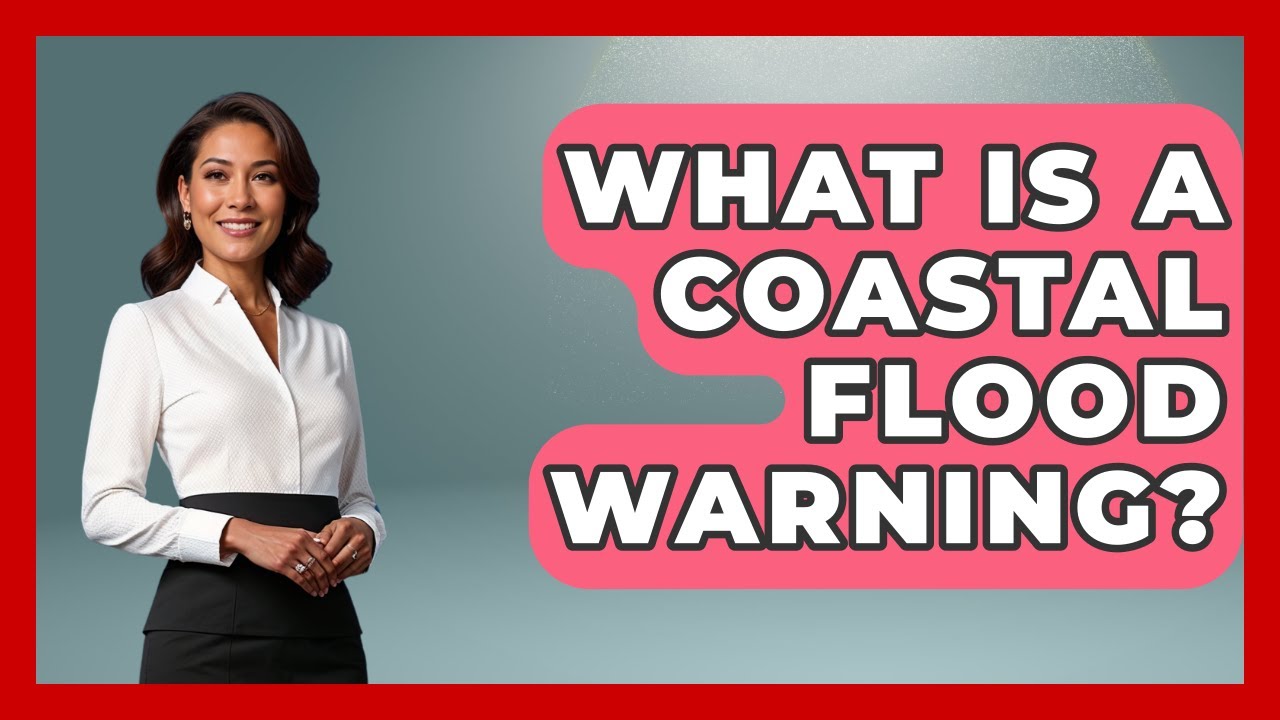A coastal flood advisory is more than just a weather alert—it’s a signal from nature that something serious is on the horizon. Whether you’re a coastal resident, a beachgoer, or someone who loves to spend time near the water, this term shouldn’t be taken lightly. This article breaks down what a coastal flood advisory means, why it matters, and what you should do when one is issued.
A coastal flood advisory typically warns of the potential for flooding in low-lying areas along the coast due to tides, wind-driven water, or storm surges. While it may not indicate life-threatening conditions like a warning might, it does suggest significant disruptions are possible. Understanding these advisories can make all the difference in protecting property and ensuring safety.
What is a Coastal Flood Advisory?
When a coastal flood advisory is issued, it’s usually because water levels are expected to rise and cause minor to moderate flooding in coastal areas. This isn’t just about waves splashing higher on the beach. We’re talking about water pushing into streets, parking lots, parks, and sometimes even into businesses and homes.
These advisories are issued by the National Weather Service and are specific to regions where flooding is likely. The exact criteria may vary depending on the geography of the area, but the core idea is that there’s enough water coming in to create hazards.
Typically, a coastal flood advisory is less severe than a coastal flood warning. The advisory implies that while flooding is expected, it will likely be manageable if the proper precautions are taken. Still, it shouldn’t be dismissed. People should remain alert and take appropriate actions to stay safe.
Causes Behind Coastal Flood Advisories
There are several causes behind a coastal flood advisory, and understanding them helps you prepare more effectively. The most common contributors include high astronomical tides, strong winds pushing water onshore, and storm surges from tropical systems or nor’easters.
High tides, especially when combined with other factors, can easily push water levels beyond what coastal infrastructure is designed to handle. Add in strong onshore winds, and you get water being physically forced inland. If there’s a storm system nearby, especially a hurricane or strong storm, storm surges can cause dramatic spikes in coastal water levels.
These events are more likely during certain times of the year, particularly in the spring and fall when king tides are more common. Urban development and rising sea levels have also made some areas more prone to coastal flooding, increasing the frequency and impact of advisories.
How to Prepare for a Coastal Flood Advisory
When a coastal flood advisory is in effect, preparation is key. That doesn’t necessarily mean you need to evacuate, but it does mean you should be alert and take preventive steps. One of the first things to do is secure outdoor belongings. Water levels can rise quickly and sweep away items like trash bins, furniture, or even small vehicles.
You should also know your area’s flood risk and have a plan. If you’re in a particularly low-lying neighborhood, consider moving your car to higher ground. Keep an eye on local news and weather apps for updates. The situation can change fast, and being informed is crucial.
Another smart move is to prepare an emergency kit. Even if flooding is expected to be minor, power outages and road closures can follow. Include bottled water, non-perishable food, flashlights, batteries, and essential medications. Planning ahead is never wasted effort.
Coastal Flood Advisory vs. Other Weather Alerts
.jpg.webp)
It’s easy to confuse a coastal flood advisory with other similar terms like flood warnings or high surf advisories, but they all mean different things. A coastal flood advisory is a specific alert aimed at flooding in coastal zones, typically affecting areas like beaches, boardwalks, and nearby neighborhoods.
A flood warning, on the other hand, signals more severe conditions. It indicates that flooding is either imminent or already happening and could pose a threat to life and property. A high surf advisory is focused more on wave action and beach erosion, not necessarily flooding inland.
Knowing the differences can help you respond appropriately. While a coastal flood advisory suggests that flooding is possible, it also suggests that it’s not an extreme emergency—yet. It provides a heads-up so you can stay ready and safe.
Impact on Daily Life
A coastal flood advisory can affect your day in multiple ways. Commuters might face flooded roads, especially near shorelines and bridges. Public transportation can also be disrupted, as routes may be blocked or delayed due to water on tracks or roads.
For homeowners and businesses in coastal areas, the advisory can be a call to action. Sandbags may be deployed, temporary flood barriers put in place, and electronics moved to higher ground. It’s all about minimizing damage.
Even if you’re just visiting, it’s a good idea to change your plans. That beach day might need to wait. Besides, even shallow water can be dangerous when it’s fast-moving or contaminated. Safety should always come first.
Environmental and Economic Impacts
Frequent coastal flood advisories are not just an inconvenience—they point to larger issues. From an environmental perspective, regular flooding can damage local ecosystems, erode coastlines, and contaminate freshwater supplies.
Economically, even minor flooding events can lead to substantial costs. Repairs, cleanup, and business interruptions add up. Insurance premiums in coastal areas often reflect this ongoing risk. For cities, repeated flooding means more public spending on infrastructure and emergency services.
Communities may need to rethink how they build and maintain roads, drainage systems, and buildings. Resilience and adaptation are key themes as the climate continues to change and sea levels rise.
Staying Safe During a Coastal Flood Advisory
Staying safe during a coastal flood advisory isn’t about panic; it’s about preparation. Always avoid walking or driving through floodwaters. Even shallow water can hide hazards like sharp debris or open manholes. Plus, vehicles can be swept away in as little as six inches of moving water.
Listen to local authorities and follow their instructions. If told to evacuate a particular zone, do it. Keep communication lines open, especially if you live alone or with vulnerable individuals. Let someone know where you are and check in regularly.
Remember that just because the water has receded doesn’t mean the danger is over. Floodwaters can leave behind slippery mud, debris, or even wildlife. Be cautious and take your time cleaning up.
Using Technology During Coastal Flood Advisories

Thanks to modern technology, it’s easier than ever to stay informed during a coastal flood advisory. Weather apps, social media, and government websites can provide real-time updates. NOAA and local weather services often send out alerts to your phone when conditions worsen.
There are also flood tracking tools and community alert systems that provide hyperlocal information. Some even offer predictive models showing when and where flooding might occur. Use these tools to plan your day and make informed decisions.
Smart home devices like flood sensors can also be a big help. These gadgets can alert you the moment water enters your basement or crawl space. The sooner you know, the quicker you can act.
The Future of Coastal Flood Advisories
As sea levels continue to rise and weather patterns grow more extreme, coastal flood advisories are expected to become more common. That means it’s more important than ever for communities to adapt and build resilience.
Cities might invest in seawalls, upgraded drainage systems, or managed retreat plans. On a personal level, people may need to consider long-term changes like elevating homes or installing sump pumps.
Policy changes will also play a role. Governments and planners need to factor in flood risk when approving new developments or infrastructure projects. Building codes might evolve, and funding for climate adaptation will become a higher priority.
Coastal Flood Advisory: In Summary
To wrap it up, a coastal flood advisory is a crucial alert that gives you time to prepare for possible flooding in coastal areas. It doesn’t mean panic, but it does mean take it seriously. Know your risks, stay informed, and take sensible actions to keep safe and minimize damage.
By understanding what a coastal flood advisory is, how it works, and what you can do, you’re better equipped to handle the challenges of living or visiting coastal areas. Nature doesn’t always give us warnings, but when it does, we should listen.
FAQs About Coastal Flood Advisory
What exactly is a coastal flood advisory?
A coastal flood advisory is a warning from weather authorities about expected minor to moderate flooding in coastal areas, usually caused by high tides, wind, or storm surge.
Is a coastal flood advisory dangerous?
While not as severe as a flood warning, it still signals potential hazards like water-covered roads, disrupted traffic, and property damage. It should be taken seriously.
How long does a coastal flood advisory last?
It varies depending on the event but usually lasts a few hours, covering the time when tides or winds are strongest.
Should I evacuate during a coastal flood advisory?
Not usually, unless instructed by local authorities. It’s more about staying alert and avoiding flood-prone areas.
What areas are most affected by coastal flood advisories?
Low-lying coastal zones, including beaches, bays, harbors, and waterfront neighborhoods are most at risk.
How can I prepare for a coastal flood advisory?
Secure loose items, move valuables to higher ground, monitor weather updates, and have an emergency kit ready.
What’s the difference between a coastal flood advisory and a flood warning?
A flood warning means flooding is already happening or imminent and is more severe. An advisory indicates possible minor flooding.
Conclusion: Stay Aware and Prepared
Coastal flood advisories are essential tools in keeping people safe from the creeping risks of rising tides and storm surges. Though not life-threatening in most cases, they give us a critical window of time to act. Stay alert, plan ahead, and respect the power of water. Awareness is your best defense.


